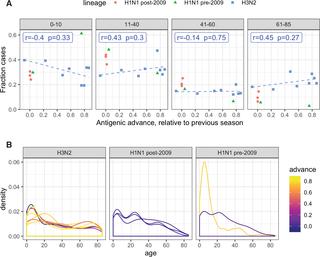当前位置:
X-MOL 学术
›
PLOS Pathog.
›
论文详情
Our official English website, www.x-mol.net, welcomes your
feedback! (Note: you will need to create a separate account there.)
Childhood immune imprinting to influenza A shapes birth year-specific risk during seasonal H1N1 and H3N2 epidemics.
PLoS Pathogens ( IF 5.5 ) Pub Date : 2019-12-19 , DOI: 10.1371/journal.ppat.1008109 Katelyn M Gostic 1 , Rebecca Bridge 2 , Shane Brady 2 , Cécile Viboud 3 , Michael Worobey 4 , James O Lloyd-Smith 1, 3
PLoS Pathogens ( IF 5.5 ) Pub Date : 2019-12-19 , DOI: 10.1371/journal.ppat.1008109 Katelyn M Gostic 1 , Rebecca Bridge 2 , Shane Brady 2 , Cécile Viboud 3 , Michael Worobey 4 , James O Lloyd-Smith 1, 3
Affiliation

|
Across decades of co-circulation in humans, influenza A subtypes H1N1 and H3N2 have caused seasonal epidemics characterized by different age distributions of cases and mortality. H3N2 causes the majority of severe, clinically attended cases in high-risk elderly cohorts, and the majority of overall deaths, whereas H1N1 causes fewer deaths overall, and cases shifted towards young and middle-aged adults. These contrasting age profiles may result from differences in childhood imprinting to H1N1 and H3N2 or from differences in evolutionary rate between subtypes. Here we analyze a large epidemiological surveillance dataset to test whether childhood immune imprinting shapes seasonal influenza epidemiology, and if so, whether it acts primarily via homosubtypic immune memory or via broader, heterosubtypic memory. We also test the impact of evolutionary differences between influenza subtypes on age distributions of cases. Likelihood-based model comparison shows that narrow, within-subtype imprinting shapes seasonal influenza risk alongside age-specific risk factors. The data do not support a strong effect of evolutionary rate, or of broadly protective imprinting that acts across subtypes. Our findings emphasize that childhood exposures can imprint a lifelong immunological bias toward particular influenza subtypes, and that these cohort-specific biases shape epidemic age distributions. As a consequence, newer and less "senior" antibody responses acquired later in life do not provide the same strength of protection as responses imprinted in childhood. Finally, we project that the relatively low mortality burden of H1N1 may increase in the coming decades, as cohorts that lack H1N1-specific imprinting eventually reach old age.
中文翻译:

甲型流感的儿童免疫印记决定了季节性 H1N1 和 H3N2 流行期间出生年份的特定风险。
在人类共同传播数十年的过程中,甲型H1N1和H3N2流感亚型引发了季节性流行病,其特点是病例和死亡率的年龄分布不同。H3N2 导致高危老年人群中大多数重症、临床就诊病例和总体死亡人数中的大多数,而 H1N1 总体死亡人数较少,且病例转向青壮年。这些对比鲜明的年龄特征可能是由于 H1N1 和 H3N2 童年印记的差异或亚型之间进化速度的差异造成的。在这里,我们分析了一个大型流行病学监测数据集,以测试儿童免疫印记是否影响季节性流感流行病学,如果是的话,它是否主要通过同亚型免疫记忆或更广泛的异亚型记忆发挥作用。我们还测试了流感亚型之间的进化差异对病例年龄分布的影响。基于可能性的模型比较表明,狭窄的亚型内印记影响季节性流感风险以及特定年龄的风险因素。这些数据不支持进化速度或跨亚型的广泛保护性印记的强烈影响。我们的研究结果强调,儿童时期的暴露可能会对特定流感亚型产生终生的免疫学偏见,而这些特定人群的偏见会影响流行病的年龄分布。因此,晚年获得的更新且不太“高级”的抗体反应无法提供与童年时期印记的反应相同强度的保护。最后,我们预计,随着缺乏 H1N1 特异性印记的人群最终步入老年,H1N1 相对较低的死亡率负担可能会在未来几十年内增加。
更新日期:2019-12-20
中文翻译:

甲型流感的儿童免疫印记决定了季节性 H1N1 和 H3N2 流行期间出生年份的特定风险。
在人类共同传播数十年的过程中,甲型H1N1和H3N2流感亚型引发了季节性流行病,其特点是病例和死亡率的年龄分布不同。H3N2 导致高危老年人群中大多数重症、临床就诊病例和总体死亡人数中的大多数,而 H1N1 总体死亡人数较少,且病例转向青壮年。这些对比鲜明的年龄特征可能是由于 H1N1 和 H3N2 童年印记的差异或亚型之间进化速度的差异造成的。在这里,我们分析了一个大型流行病学监测数据集,以测试儿童免疫印记是否影响季节性流感流行病学,如果是的话,它是否主要通过同亚型免疫记忆或更广泛的异亚型记忆发挥作用。我们还测试了流感亚型之间的进化差异对病例年龄分布的影响。基于可能性的模型比较表明,狭窄的亚型内印记影响季节性流感风险以及特定年龄的风险因素。这些数据不支持进化速度或跨亚型的广泛保护性印记的强烈影响。我们的研究结果强调,儿童时期的暴露可能会对特定流感亚型产生终生的免疫学偏见,而这些特定人群的偏见会影响流行病的年龄分布。因此,晚年获得的更新且不太“高级”的抗体反应无法提供与童年时期印记的反应相同强度的保护。最后,我们预计,随着缺乏 H1N1 特异性印记的人群最终步入老年,H1N1 相对较低的死亡率负担可能会在未来几十年内增加。











































 京公网安备 11010802027423号
京公网安备 11010802027423号